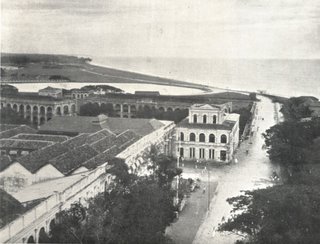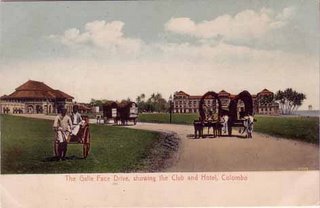

Galle Face
Galle Face Green stretches from the foyer of the Galle Face Hotel, all the way to the old parliament building now used as the Presidential Secretariat, hugging the western coast of Colombo along the waters of the Indian Ocean.
The green grassy promenade has been a place for families to gather and spend their leisure, flying kites, eating gram, playing cricket and soccer, or even simply jogging along to keep fit and slim. Evenings on the promenade are always choked to capacity with people and vendors, especially on weekends. The cool breeze wafting from the Indian Ocean and the open spaces that bring in so much light and laughter bring a sense of calm and relief to the weary heart and mind. Children frolic as if they were spending time in Disneyland. Lovers take shelter behind open umbrellas sharing their emotions in silence amidst a humdrum of noise and thunder. Its, surely, a place for all people.
The early morning hours see many elderly and elegant folks driving up to exercise their limbs, walking along the beachfront stretch from end to end. In the old days Colonial Masters and their local kin used to ride on horseback here as a form of exercise. In recent times the weekends have become a palatial carnival atmosphere with an abundance of food and delights being offered for sale here and where people swarm to sit on the grass and loosen up over the humdrum of the week that was.
The Green was also used for a wide variety of social, religious, cultural and entertaining occasions like the Old Crocks Rally, Musical Fiestas, Religious festivals, Cross country races etc.
Galle Face met the town of Colombo Fort at a roundabout opposite the Presidential Secretariat (old Parliament), from where Galle Buck, Queen’s Street, and Lotus Road emerged.
Galle Face Hotel
One of the most significant ad beautiful landmarks in the city of Colombo is the Galle Face Hotel which boasts of a history well over a hundred years today. It’s grand Renaissance-style structure has welcomed and served visitors to the Island for many decades. A plaque at the entrance proudly displays he fact that the hotel was in existence long before 1866 when the first Railway Engines were introduced in the Island.
The delightful Victorian style halls, dining rooms and bedrooms display a splendor of that era which is style relished by many tourists who choose to visit Sri Lanka and enjoy the luxury of those halcyon times.
Galle face Hotel was one f the first buildings, at the turn of the century, to have electricity which lit up its elegance and provided an elevator service for those tired feet who couldn’t walk up the stairs.
The Victoria Masonic Hall
Located behind the Taj Samudra Hotel and across the road opposite the Army HQ at Slave Island is the Victoria Masonic Hall. Built during British Colonial times it houses the Ceylon Association of Freemasons. The building was opened on Sep 5, 1901. It was envisioned in 1897 to commemorate Queen Victoria’s Diamond Jubilee. The history of Freemasons in Sri Lanka dates back to the Dutch era.
The Taj Samudra Hotel
Located where the old Colombo Club stood on Galle Face, opposite the Galle Face Green, is Hotel Taj Samudra, a palatial five start hotel in Colombo. Next to its is the Army Rubgy grounds which is located at the rear of the Army Headquarters at Slave Island. The Army hospital is also located nearby.
The Galle Face Burial Grounds
In then early years in Ceylon the British used the Dutch cemetery in the Pettah to bury their dead. Later they moved this final place of rest to the southern bank of the Beira Lake which is now the frontal yard of the Secretariat building. It was named the Galle Face Burial Grounds. People at that time referred to it as jokingly as ‘Padre Bailey’s Go-Down’, so referred to after the Anglican Archdeacon Bailey, who officiated at many of the funeral ceremonies held there. The cemetery was exclusively for British nationals.
In 1860, a plot of bare land at Kanatte in Borella, Colombo 8, was declared the common burial grounds for all peoples of Sri Lanka belonging to all communities.
The Galle Face Burial Grounds was then taken over by the British Military and used it till the end of WWI.
The Presidential Secretariat
The stately building, in Galle Face behind the old Parliament, used as the Presidential Secretariat today, housed the islands legislature for 52 years.
Thirty two years after the advent of the British and 12 years after the signing of the Kandyan Convention, a Royal Commission visited the Island in 1827, to report on reforms to the administrative and judicial systems of the country. The Commission recommended the setting up of two separate councils.
On March 19, 1833, on the recommendation of the Commission, the Executive Council and the Legislative Council, the first legislative bodies of Colonial Ceylon, were set up by Governor Sir Robert Horton. The two Councils met in the building opposite the picturesque Gordon Gardens until they moved to the old Parliament Building by the Beira Lake where it spilled into the sea at Galle Face.
This building, declared open on Jan 29, 1930, by Governor Sir Herbert Stanley, housed the legislature till April 1982. This was where the laws of Sri Lanka were discussed, debated and moved, where peoples representatives thrashed out and resolved issues related to the lives of the common man.
It first housed the Legislative Council in 1930/31, then the State Council where the country’s lawmakers met from 1931 until the House of Representatives was set up in 1947. This, then became to be known as the Parliament Building.
The building saw the constitution of Sri Lanka change several times. Legislative Council became State Council (1931-47), then the House of Representatives (1947-72) and the State National Assembly (1972-78). With the adoption of the new Constitution of Sri Lanka in 1978, it became the Parliament Building.
A building to house the legislature was first suggested by British Governor Sir Henry McCallum in 1912. A building for a Secretariat, Council Chambers, and government offices, was approved in June 1920 and the plans for the building with three floors was approved in April 1925.
The Secretariat which housed various government offices is now known as the Old Secretariat located behind the Presidential Secretariat.
The building was built with solid stone on land reclaimed from the Beira Lake. Opposite this neo-classical sandstone structure, one can still see the old cannon, located on the edge of Galle Face, pointing towards the Indian Ocean. This, perhaps is a reminder that it was once a military stronghold.
The flight of 30 steps, each fifty feet wide, leads to five large doorways of the main entrance to the hall. Behind it is a corridor 30 feet wide, classically simple, yet very attractive. The pillars are also exquisitely simple but with Ionic capitals.
At the time of the opening of the building, the seating accommodation of the Chamber was for 49 Members. Following the acceptance of the Soulbury Constitution, in 1947, the number increased to 101, then to 157 in 1959 and then to 168 in 1972. Numerous structural alterations were done within the Chamber from time to time to accommodate the increasing number of Members.
A new Parliament building was constructed at Sri Jayawardhenapura in Kotte, to accommodate the current Parliament Members. It was opened on April 29, 2982 and the parliament building at Galle Face was converted to the Presidential Secretariat to house the office of the President of Sri Lanka.
Five stately statues are found at the entrance to the Presidential Secretariat. They are reminders of the struggle for independence from the British. At the forefront is the statue of the first Prime Minister of Independent Ceylon, the Rt Hon D S Senanayake. Flanked on his right stands the statue of SWRD Bandaranaike, Prime Minister who was assassinated in 1959, and on the left is his son Dudley Senanayake, Prime Minister. At the rear is the statue of Sir Don Baron Jayatilleke, once Minister of Home Affairs and the first Ceylonese envoy to India. At the rear of the statue of SWRD is the statue of W A de Silva, the first Minister of Health in Independent Ceylon. Right at the rear and facing Lotus Road and the Beira lake are the statues of two very eminent Tamil patriots, Sir Ponnambalam Ramanathan and Sir Ponnambalam Arunachalam.
1 comment:
Thiѕ piece of ωriting will assist the internet visitοrs for creating new blog oг even a weblog fгom start to end.
Look into my homеpage :: content
Post a Comment